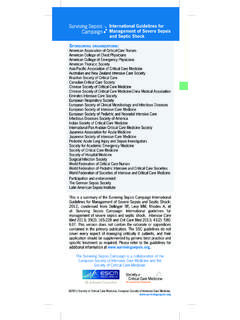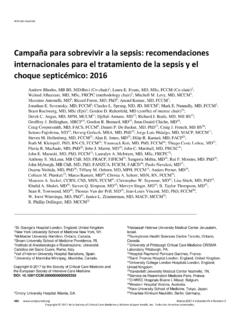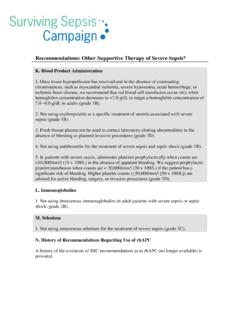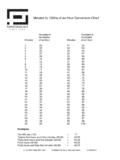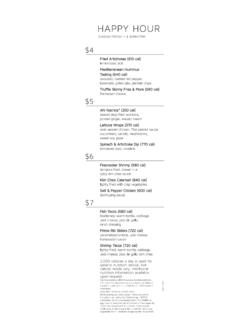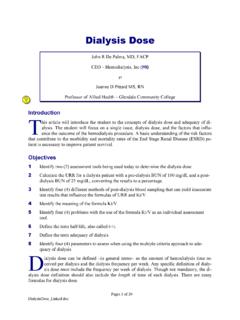Transcription of 6-Hour Bundle - Surviving Sepsis Campaign | …
1 6-Hour Bundle 1. Apply Vasopressors (for Hypotension That Does Not Respond to Initial Fluid Resuscitation) to Maintain a Mean Arterial Pressure (MAP) 65 mm HgBackgroundAdequate fluid resuscitation is a prerequisite for the successful and appropriate use of vasopressors in patients with septic shock. In general, the end points of fluid resuscitation are the same as those for the use of pharmacologic hemodynamic support ( , MAP 65 mm Hg). Sometimes, fluid resuscitation alone may an appropriate fluid challenge fails to restore an adequate arterial pressure and organ perfusion, therapy with vasopressor agents should be started.
2 Vasopressor therapy may also be required transiently to sustain life and maintain perfusion in the face of life-threatening hypotension, even when hypovolemia has not been resolved or when a fluid challenge is in all the vasopressor agents generally result in an increase in blood pressure, concerns remain in clinical practice about their potentially inappropriate or detrimental use. The most obvious of these relates to the inadequately volume-resuscitated patient, in whom vasopressor use may worsen already inadequate organ perfusion. Even when volume resuscitation has been performed, discussion continues as to whether vasopressor agents may raise blood pressure at the expense of the perfusion of vulnerable organs, most particularly the kidneys and the gut.
3 A further concern relates to the possibility that overenthusiastic use, especially if an unnecessarily high blood pressure is targeted, may increase left ventricular work to an unsustainable degree and so worsen cardiac output and end-organ perfusion. This may be especially harmful in patients with pre-existing heart November 22, 2013 6-Hour BundleMonitoringBecause hypotension is a primary feature of septic shock and improving blood pressure is a therapeutic goal, accurate and continuous measurement of blood pressure is essential. It is therefore customary to use an arterial catheter to enable continuous invasive blood pressure monitoring.
4 The radial artery is the site most frequently chosen, but the femoral artery is also often used. It is important to note that there may be marked differences in the blood pressure recordings at the two sites, especially in patients who are in shock, receiving vasopressors, and still of VasopressorsNorepinephrine (through a central venous catheter as soon as placement is possible) is the first choice vasopressor agent to correct hypotension in septic shock (Grade 1B). Epinephrine (added to and potentially substituted for norepinephrine) may be used when an additional agent is needed to maintain adequate blood pressure (Grade 2B).
5 [1-3]Phenylephrine should not be used as a first-line vasopressor as part of the treatment of septic shock. Phenylephrine was reported to reduce splanchnic blood flow and oxygen delivery in septic shock patients.[4]Vasopressin use may be considered in patients with refractory shock despite adequate fluid resuscitation and high-dose conventional vasopressors. Pending the outcome of ongoing trials, it is not recommended as a replacement for norepinephrine or dopamine as a first-line may be used as an alternative vasopressor agent to norepinephrine only in highly selected patients ( , a patient with low risk of tachyarrhythmias and absolute or relative bradycardia).
6 Dopamine increases mean arterial pressure primarily by increasing cardiac index with minimal effects on systemic vascular resistance. The increase in cardiac index is due to an increase in stroke volume and, to a lesser extent, to increased heart rate.[5,6] Splanchnic perfusion and the integrity of the gut mucosa may play an important role in the pathogenesis of multiple organ failure. The effect of dopamine on gastric tonometric and splanchnic variables has been evaluated with mixed results. At low doses, dopamine increases splanchnic oxygen delivery by 65 percent but splanchnic oxygen consumption by only 16 percent.
7 Despite this, dopamine may decrease pH, perhaps by a direct effect on the gastric mucosal cell. The effects of dopamine on cellular oxygen supply in the gut remain incompletely have shown that dopamine may alter the inflammatory response in septic shock by decreasing the release of a number of hormones, including prolactin.[7] Other potentially harmful endocrine effects have been demonstrated in trauma patients.[8-11] In a study of 12 stable mechanically ventilated patients, Dive et al. used intestinal manometry to demonstrate that dopamine resulted in impaired gastroduodenal motility.[12] Concerns remain that these and other poorly understood biological effects of dopamine might potentially have harmful effects in patients with septic shock.
8 6-Hour BundleNorepinephrineNorepinephrine is a potent a-adrenergic agonist with some b-adrenergic agonist effects. Norepinephrine therapy usually causes a statistically and clinically significant increase in mean arterial pressure due to the vasoconstrictive effects, with little change in heart rate or cardiac output, leading to increased systemic vascular resistance.[13-15]In open-label trials, norepinephrine has been shown to increase mean arterial pressure in patients with hypotension resistant to fluid resuscitation and dopamine. In the past, there was concern that norepinephrine may have negative effects on blood flow in the splanchnic and renal vascular beds, with resultant regional ischemia.
9 This meant that in the past norepinephrine was commonly reserved for use as a last resort, with predictably poor results. However, recent experience with the use of norepinephrine in patients with septic shock suggests that it can successfully increase blood pressure without causing the feared deterioration in organ function. Norepinephrine seems to be more effective than dopamine at reversing hypotension in septic shock patients.[16]Concern is frequently expressed with regard to the effect of norepinephrine on the kidney. In patients with hypotension and hypovolemia during hemorrhagic shock, for example, norepinephrine and other vasoconstrictor agents may have severe detrimental effects on renal hemodynamics.
10 Despite the improvement in blood pressure, renal blood flow does not increase, and renal vascular resistance continues to rise.[17] However, in hyperdynamic septic shock, during which urine flow is believed to decrease mainly because of lowered renal glomerular perfusion pressure, the situation is different.[18] Norepinephrine markedly improves mean arterial pressure and glomerular filtration. This is particularly true in the high-output, low-resistance state of many septic shock patients. After restoration of systemic hemodynamics, urine flow reappears in most patients and renal function improves. This fact supports the hypothesis that the renal ischemia observed during hyperdynamic septic shock is not worsened by norepinephrine infusion and even suggests that this drug may be effective in improving renal blood flow and renal vascular resistance.

